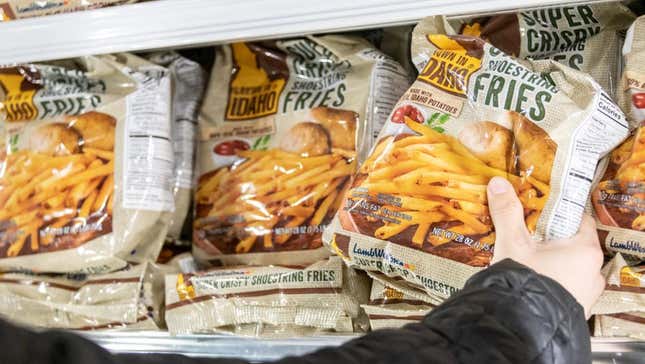
As long as people have been sourcing sundries, there’s been a select few thrifty folks who have shopped around from store to store looking for the best deals before they buy. The whole concept of a supermarket is to make grocery shopping as convenient as possible, however, and most of us accept the tradeoff that not every product is the best deal at any one store in favor of making one stop for everything you need. But lately, now that $100 feels a lot like the new $10 thanks to record-breaking inflation, it’s not just coupon clippers who are abandoning store loyalty and convenience in favor of finding the best deals.
According to recent data from the Dunnhumby Consumer Trends Tracker, despite inflation numbers easing after eye-popping increases in 2021 and 2022, people are still very much feeling the pinch at the supermarket, and they’re increasingly willing to visit multiple stores to find better prices. In fact, among the 2,000 people polled for the ongoing study in April, 40% reported shopping at multiple grocery stores to find lower prices, which is up 5% from the study’s last wave in 2022, and reflects a 9% increase year over year.
How prices influence our shopping patterns
For Ruth Miller of Richmond, Vermont, shopping around at different stores and farm stands has always been a part of her regular routine, but price spikes and fluctuations have made the practice even more important.
“Inflation has caused me to seek out more specials and buy less meat, especially from area farms (local eggs are still the best quality and a good deal),” said Miller.
A big part of the phenomenon seems to be that people’s perceptions peg inflation as significantly higher than the actual numbers—think of it as the “feels like” numbers when you read a weather forecast. While the actual rate of inflation was around 7% at the time the report was released, people responding to the year-long study reported that the increases felt as much as 15 points higher. Overall, shoppers also reported that they’re less interested in “getting in and out quickly” and “fast easy checkout,” which are 2% declines for both questions compared to the study’s last wave. Instead, they are taking their time to find the best prices.
How consumers search for the best value
Not all groceries were rated the same in the study. There are still several products and categories in which respondents report maintaining brand loyalty, including pharmacy (46%), baby care (25%), deli meat (23%), ready-to-eat meals freshly prepared at the store (22%), and seafood (21%). The stuff people tend to shop around for includes non-alcoholic beverages (60%), packaged food (55%), and frozen food (54%). Unsurprisingly, families experiencing food insecurity and cuts to the federal Supplemental Nutrition Assistance Program (SNAP) are more likely to be visiting multiple stores for lower prices, although they are also still very brand loyal for baby care products and ready-to-eat meals.
David Duncan Virr, who lives in the greater Boston area and frequents approximately five different supermarkets in addition to farm stands and farmers markets, affirms those findings. He also points out that a big part of shopping around is cultivating an awareness of each store’s price ranges.
“In my younger, poorer days I’d only buy items I knew I was going to eat in the next few days—that way nothing went bad or got eaten by roommates,” said Virr. “That meant visiting different stores based on where I’d be passing by, or if I needed a specific item. I’d try to buy most of my produce and meat at stores with a good selection. Packaged foods—pasta, snacks, ice cream, etc.—I’d mostly buy by price, knowing that Market Basket would be cheaper than Shaw’s, which in turn was cheaper than Whole Foods.”
Even though grocery store inflation is slowing down, prices are also not reverting to pre-pandemic levels. So while grocery bills aren’t still increasing exponentially, the new normal is significantly more expensive than it was just two or three years ago, and people are searching for any way to cut costs. Some folks are paying for groceries with credit. Instant noodles are more beloved than ever. The Dunnhumby Tracker even reported that nearly 40% of younger Americans skip meals to save money. So in the grand scheme of things, shopping at five different stores throughout the week makes sense. Just don’t go wasting gas trying to find the best deals, or you won’t save any money at all.
“I always piggyback shopping trips and [other] errands to make best use of gas mileage,” said Miller. “Our local independent market is excellent, has competitive prices, and is right on my street—a five-minute walk.”